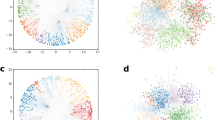Abstract
The \(\mathbb {S}^1\) model has been central in the development of the field of network geometry. It places nodes in a similarity space and connects them with a likelihood depending on an effective distance which combines similarity and popularity dimensions, with popularity directly related to the degrees of the nodes. The \(\mathbb {S}^1\) model has been mainly studied in its homogeneous regime, in which angular coordinates are independently and uniformly scattered on the circle. We now investigate if the model can generate networks with targeted topological features and soft communities, that is, inhomogeneous angular distributions. To that end, hidden degrees must depend on angular coordinates, and we propose a method to estimate them. We conclude that the model can be topologically invariant with respect to the soft-community structure. Our results expand the scope of the model beyond the independent hidden variables limit and can have an important impact in the embedding of real-world networks.


Similar content being viewed by others
Notes
The original model defined in [4] is in fact more general, allowing for any connection probability \(p_{ij}\) as long as it depends on the argument \(d_{ij}/(\kappa _i \kappa _j)^{1/D}\), where the space is the D-dimensional sphere and \(d_{ij}\) the geodesic distance on the sphere. The particular functional form in Eq. (1) allows us to interpret the network as a set of non-interacting fermions (the links) embedded in the hyperbolic plane, with the hyperbolic length of a link playing the role of its energy and \(\beta \) playing the role of the inverse of the bath temperature [5].
The ordering of the target degrees might not be necessary in a more general situation where, for instance, hidden degrees are not correlated with angles.
References
Newman, M.E.J.: Networks: An Introduction. Oxford University Press, Oxford (2010)
Dorogovtsev, S.N., Mendes, J.F.F.: Accelerated Growth of Networks. Handbook of Graphs and Networks. Wiley-VCH, Berlin (2003)
Barabási, A.L., Albert, R.: Emergence of scaling in random networks. Science 286, 509 (1999)
Serrano, M.Á., Krioukov, D., Boguñá, M.: Self-similarity of complex networks and hidden metric spaces. Phys. Rev. Lett. 100, 078701 (2008)
Krioukov, D., Papadopoulos, F., Vahdat, A., Boguñá, M.: Hyperbolic geometry of complex networks. Phys. Rev. E 80, 035101 (2009)
Boguñá, M., Papadopoulos, F., Krioukov, D.: Sustaining the internet with hyperbolic mapping. Nat. Commun. 1, 62 (2010)
Serrano, M.Á., Boguñá, M., Sagués, F.: Uncovering the hidden geometry behind metabolic networks. Mol. BioSyst. 8, 843 (2012)
García-Pérez, G., Boguñá, M., Allard, A., Serrano, M.Á.: The hidden hyperbolic geometry of international trade: World Trade Atlas 1870–2013. Sci. Rep. 6, 33441 (2016)
Newman, M.E.J., Girvan, M.: Finding and evaluating community structure in networks. Phys. Rev. E 69, 026113 (2004)
Radicchi, F., Castellano, C., Cecconi, F., Loreto, V., Parisi, D.: Defining and identifying communities in networks. Proc. Natl. Acad. Sci. USA 101, 2658 (2004)
Arenas, A., Fernández, A., Gómez, S.: Analysis of the structure of complex networks at different resolution levels. New J. Phys. 10(5), 053039 (2008)
Zuev, K., Boguñá, M., Bianconi, G., Krioukov, D.: Emergence of soft communities from geometric preferential attachment. Sci. Rep. 5, 9421 (2015)
Papadopoulos, F., Kitsak, M., Serrano, M.Á., Boguñá, M., Krioukov, D.: Popularity versus similarity in growing networks. Nature 489(7417), 537 (2012)
Muscoloni, A., Cannistraci, C.V.: A nonuniform popularity-similarity optimization (nPSO) model to efficiently generate realistic complex networks with communities. New J. Phys. 20, 052002 (2018)
Krioukov, D., Papadopoulos, F., Kitsak, M., Vahdat, A., Boguñá, M.: Hyperbolic geometry of complex networks. Phys. Rev. E 82, 036106 (2010)
Gulyás, A., Bíró, J.J., Kőrösi, A., Rétvári, G., Krioukov, D.: Navigable networks as Nash equilibria of navigation games. Nat. Commun. 6, 7651 (2015)
García-Pérez, G., Boguñá, M., Serrano, M.A.: Multiscale unfolding of real networks by geometric renormalization. Nat. Phys. 14, 583–589 (2018)
Allard, A., Serrano, M.Á., García-Pérez, G., Boguñá, M.: The geometric nature of weights in real complex networks. Nat. Commun. 8, 14103 (2017)
Acknowledgements
We acknowledge support from a James S. McDonnell Foundation Scholar Award in Complex Systems; the ICREA Academia prize, funded by the Generalitat de Catalunya; Ministerio de Economía y Competitividad of Spain Projects No. FIS2013-47282-C2-1-P and no. FIS2016-76830-C2-2-P (AEI/FEDER, UE).
Author information
Authors and Affiliations
Corresponding author
Rights and permissions
About this article
Cite this article
García-Pérez, G., Serrano, M.Á. & Boguñá, M. Soft Communities in Similarity Space. J Stat Phys 173, 775–782 (2018). https://doi.org/10.1007/s10955-018-2084-z
Received:
Accepted:
Published:
Issue Date:
DOI: https://doi.org/10.1007/s10955-018-2084-z




